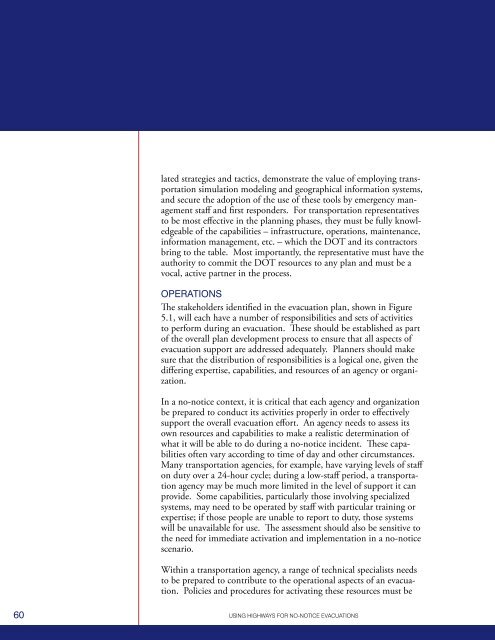using highways for no-notice evacuations - FHWA Operations - U.S. ...
using highways for no-notice evacuations - FHWA Operations - U.S. ...
using highways for no-notice evacuations - FHWA Operations - U.S. ...
Create successful ePaper yourself
Turn your PDF publications into a flip-book with our unique Google optimized e-Paper software.
lated strategies and tactics, demonstrate the value of employing transportationsimulation modeling and geographical in<strong>for</strong>mation systems,and secure the adoption of the use of these tools by emergency managementstaff and first responders. For transportation representativesto be most effective in the planning phases, they must be fully k<strong>no</strong>wledgeableof the capabilities – infrastructure, operations, maintenance,in<strong>for</strong>mation management, etc. – which the DOT and its contractorsbring to the table. Most importantly, the representative must have theauthority to commit the DOT resources to any plan and must be avocal, active partner in the process.OPERATIONSThe stakeholders identified in the evacuation plan, shown in Figure5.1, will each have a number of responsibilities and sets of activitiesto per<strong>for</strong>m during an evacuation. These should be established as partof the overall plan development process to ensure that all aspects ofevacuation support are addressed adequately. Planners should makesure that the distribution of responsibilities is a logical one, given thediffering expertise, capabilities, and resources of an agency or organization.In a <strong>no</strong>-<strong>no</strong>tice context, it is critical that each agency and organizationbe prepared to conduct its activities properly in order to effectivelysupport the overall evacuation ef<strong>for</strong>t. An agency needs to assess itsown resources and capabilities to make a realistic determination ofwhat it will be able to do during a <strong>no</strong>-<strong>no</strong>tice incident. These capabilitiesoften vary according to time of day and other circumstances.Many transportation agencies, <strong>for</strong> example, have varying levels of staffon duty over a 24-hour cycle; during a low-staff period, a transportationagency may be much more limited in the level of support it canprovide. Some capabilities, particularly those involving specializedsystems, may need to be operated by staff with particular training orexpertise; if those people are unable to report to duty, those systemswill be unavailable <strong>for</strong> use. The assessment should also be sensitive tothe need <strong>for</strong> immediate activation and implementation in a <strong>no</strong>-<strong>no</strong>ticescenario.Within a transportation agency, a range of technical specialists needsto be prepared to contribute to the operational aspects of an evacuation.Policies and procedures <strong>for</strong> activating these resources must be60 USING HIGHWAYS FOR NO-NOTICE EVACUATIONS
















